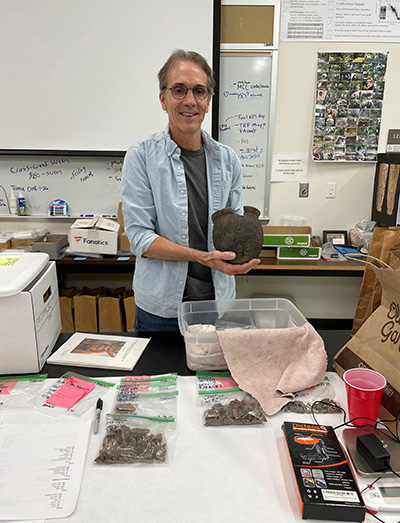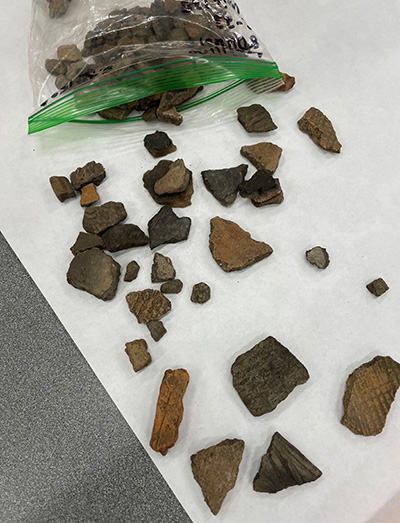Anthropology professor discusses his life's work and passion
Walking into the Archaeology Lab at the University of North Florida is like time-traveling to another period.
 Nestled in crooks and crannies and scattered along tables and countertops are pieces of pottery, copper, shells and other relics that people who lived more than 1,000 years ago touched, used, traded and gifted to one another.
Nestled in crooks and crannies and scattered along tables and countertops are pieces of pottery, copper, shells and other relics that people who lived more than 1,000 years ago touched, used, traded and gifted to one another.“There’s a purpose for and a story about almost everything in this room from America’s past,” said Dr. Keith Ashley, associate professor of anthropology and director of the Archaeology Lab. “It’s amazing to learn about these items and the way people once lived thousands of years ago – their customs and traditions.”
Ashley’s love affair with all things ancient and old began at a young age but didn’t take root until he was a student at Auburn University.
“I was studying engineering and taking a statics/physics class and had this epiphany – this wasn’t what I wanted to do for the rest of my life,” Ashley said. “I couldn’t see myself in a coat and tie sitting behind a desk all day. I like being outdoors too much.”
The next day he looked up archaeology in the school catalog but didn’t find any information not realizing archeology was a sub-discipline under anthropology.
Then chance happened – he was walking through a building in between classes and discovered the archaeology lab.
“I walked in, spoke to the professor and signed up for classes the next day,” Ashley said. “Two weeks later, I went on a field project and never looked back.” Except, when he’s looking back into the lives of the Indigenous people of Northeast Florida and their relationships with the Europeans and other Indigenous groups – his life’s work for more than 25 years.
“I’m interested in the deep past of Indigenous peoples, but it’s important to keep in mind, there are contemporary Indigenous peoples still living here today,” explained Ashley. “We don’t just want to look at them as relics of the past.”
In fact, Ashley and his colleague Dr. Denise Bossy, associate professor of history and a leading expert in Native American history, have built relationships with several native nations around the U.S., including the Seminole and Miccosukee Indians prevalent in Florida and the Muscogee Nation of Oklahoma.
The pair were recently awarded a $250,000 grant from the National Endowment for the Humanities, to collaborate and combine their expertise on a book that tells the story of Indigenous nations who lived in the area more than a thousand years ago. They plan to consult with many Indigenous people as well.
“The grant affords us the opportunity to delve deep into the history of Indigenous nations prevalent to Northeast Florida and Southeast Georgia,” Ashley said. “The book will focus on their everyday lives from how they lived, to their different dialects, creating alliances and diplomatic relationships, to their pilgrimages and trade networks.”
“It’s important work that will appeal to many people interested in learning more about native nations, but specifically to historians and archeologists and to Indigenous people themselves.”
 For the past four summers, Ashley and his students have been working on a project he started 20 years ago, in a wooded area on Big Talbot Island called Sarabay.
For the past four summers, Ashley and his students have been working on a project he started 20 years ago, in a wooded area on Big Talbot Island called Sarabay.“Sarabay is a Mocama town that dates back to the late 1500s and early 1600s,” said Ashley. “After a 20-year hiatus, we went back in and started digging again. With help from historical documents, surveys and shovel tests, we discovered the community’s council house – a center of living.”
Another project started in 1998, is the Mill Cove Complex located on private property in Ft. Caroline, that Ashley says has ties to the Cahokia Indians who lived in the Missouri and Illinois regions.
“We’ve been working on the Mill Cove Complex project off and on since 1998,” Ashley explained. “It dates back a thousand years and we know from our findings, the Cahokia traveled here and had interactions with other Indigenous groups in this area,” said Ashley.
A more recent project he’s working on with one of his anthropology students, Victoria Hayes, is on National Park Service land and includes mapping and researching huge shell mounds on Black Hammock Island.
Although Ashley says archaeological digging is a slow process and most sites are vast, he doesn’t mind.
“Archaeology is a work in progress – something always needs to be refined, reputed, interpreted or strengthened,” Ashley said. “I’m totally in my element, exactly where I want to be and how I always wanted to devote my career – immersed in the history of the Indigenous people of Northeast Florida.”
